| Pages:
1
2 |
IrC
International Hazard
    
Posts: 2710
Registered: 7-3-2005
Location: Eureka
Member Is Offline
Mood: Discovering
|
|
Vacuum
Decided a topic is warranted for this subject. Anything related is on topic, whether hardware, materials, glues, pumps, links, or you name it.
http://www.belljar.net/articles.htm
http://www.clevelandfx.com/crazylou/tutorials/vacuum.htm
http://www.vacuumlab.com/articles.htm
http://shop.ebay.com/?_from=R40&_trksid=p3984.m570.l1313...
http://www.lesker.com/newweb/menu_literature.cfm
Just a few links for some interesting reading and one for a seller of various gauges. On the subject from another thread I must add my Plexiglas
problems were insurmountable. I was buying it from various local hardware stores. Several attempts and every time I had problems with cracking with
the slightest pressure, and epoxy failing to adhere. I am convinced this is due to the formulation and/or manufacturing of the Plexiglas now coming
from China. I used 3/4" fiberboard as a backing to eliminate problems with warping and several sheets glued together to reach about an inch in
thickness (~1.75" total). Same cracking and glue not adhering problems each time. Out of desperation (and a wasted $140), I sacked an old plating bath
vessel for some sheets of 30 odd year old Plexiglas. Worked perfect, after curing no leaks and zero cracks from the hardware which bolts the stack of
sheets (also glued each layer) together. I would be interested in anyone's opinion on this.
Edit to add: also on topic are projects using vacuum so if you are doing high energy research or something else entirely by all means show and tell. I
could not decide if this topic should be here or in technical so no problems if mods move it. While constructing vacuum setups is why I chose this
section I believe often we learn new ideas to apply in building a setup by learning in detail about projects using vacuum (even distillation work)
where problems were encountered by studying the methods used to overcome said problems. Possibly I am being too broad yet I see no other way to cover
everything if we limit ourselves too a narrow spectrum of discussion.
[Edited on 12-27-2010 by IrC]
"Science is the belief in the ignorance of the experts" Richard Feynman
|
|
|
watson.fawkes
International Hazard
    
Posts: 2793
Registered: 16-8-2008
Member Is Offline
Mood: No Mood
|
|
Gettering and Ion Pumping. This article is available at http://www.aiv.it/attivita/articoli.html; articles are variously in English and Italian.
|
|
|
User
Hazard to Others
  
Posts: 339
Registered: 7-11-2008
Location: Earth
Member Is Offline
Mood: Passionate
|
|
Well in that case 
I am wondering if anyone has ever improvised things such a kickback flasks ,washing bottles, oil pump exhausts/filters ?
Currently I'm designing a system for my lab and some good suggestions are very welcome.
What a fine day for chemistry this is.
|
|
|
IrC
International Hazard
    
Posts: 2710
Registered: 7-3-2005
Location: Eureka
Member Is Offline
Mood: Discovering
|
|
This is the next pump I added to my vacuum station, around a grand used rebuilt, good to 0.1 micron. So I have a single stage rotary for rough to
around 70 microns, a new 2 stage to one micron, and If I can work the plumbing out I will add the 0.1 micron Alcatel. It runs very quietly. For now I
think I will just clean it and do an oil change, test it to see how well it does. Will take some plumbing work to keep a nice short, large diameter
route into the base of my bell jar platform but worth it. Best I could do before this one was around 1 micron. This hobby is expensive, a grand to
move the decimal point by one place from 1 to 0.1.
The Alcatel only had a few days worth of run time with the oil kept clean by changing, then was stored for a few years. Kind of wondering if I should
buy the rebuild kit before I start using it because it was stored (but never run) in a desert sandy location. Every time I went to that storage room
sand was across the floor from blowing in under the door. I worry that there could be microscopic particles of sand in there even though I flushed it
out and put new oil in. The exhaust muffler only had a cloth plug in it to keep dirt in the air out. Pic below is just off the web, when I get around
to it I'll take a pic of the one I have here (identical to the advertising pic below).
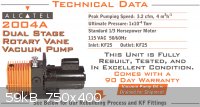
[Edited on 12-29-2010 by IrC]
"Science is the belief in the ignorance of the experts" Richard Feynman
|
|
|
watson.fawkes
International Hazard
    
Posts: 2793
Registered: 16-8-2008
Member Is Offline
Mood: No Mood
|
|
Quote: Originally posted by IrC  | | On the subject from another thread I must add my Plexiglas problems were insurmountable. I was buying it from various local hardware stores. Several
attempts and every time I had problems with cracking with the slightest pressure, and epoxy failing to adhere. I am convinced this is due to the
formulation and/or manufacturing of the Plexiglas now coming from China. |
It's also possible that you're
seeing the difference between cast acrylic and extruded acrylic. The cast product is superior and costs more. Guess which one is more likely in the
hardware store, available to plastics newbies? I get my acrylic at a local sign shop, usually out of the scrap pile they sell off by the pound, since
I rarely need anything window-sized.
While I saw your problem before, it didn't occur to me until today what the problem might be.
|
|
|
IrC
International Hazard
    
Posts: 2710
Registered: 7-3-2005
Location: Eureka
Member Is Offline
Mood: Discovering
|
|
Thanks for the advise. Somehow I doubt if I asked they would even know the difference. No local sign shop just a couple hardware places. Made me sad
to cut up my tank. I had saved it to build a big PCB etching setup, even had bought two pumps for circulation. Now I see I do not want to build one
someday from anything available around here. Helpful info, when I do build another tank I will have to drive over 200 miles round trip. If they cannot
say for sure it is extruded I will have to keep looking. Will have to study up on how to tell the difference. One thing is I noticed the old tank
walls drill easily without trying to tear chunks unlike the local (cast?) stuff. When I was building with the new stuff I had to step up in 1/64
increments. Took only three bit sizes to get to a 1/4" hole with the old material, no sign of bit grabbing either. Cast you say. Good idea.
[Edited on 12-29-2010 by IrC]
"Science is the belief in the ignorance of the experts" Richard Feynman
|
|
|
vulture
Forum Gatekeeper
    
Posts: 3330
Registered: 25-5-2002
Location: France
Member Is Offline
Mood: No Mood
|
|
You might want to invest in some fomblin or other perfluorinated oil, less oil mist and crap usually floats on top. Not really necessary if you don't
use corrosive chemicals.
One shouldn't accept or resort to the mutilation of science to appease the mentally impaired.
|
|
|
IrC
International Hazard
    
Posts: 2710
Registered: 7-3-2005
Location: Eureka
Member Is Offline
Mood: Discovering
|
|
I don't pump down any chemical experiments, mostly physics type experiments. Looked at the price and it is high for that oil. For anything chemistry
related I have a few Gast diaphragm types which would survive corrosion better and in general are inexpensive pumps. Thinking about removing the top
pump as it barely does 150 microns and I need room for large tubing for the Alcatel. Besides I have learned through experience it is better for two
pumps to be closer together in maximum vacuum capability.
Below are a few pics of my system. I built it for getting down in the 55 micron range and providing various plumbing to allow gasses in for laser
work. Wanting to play with the Farnsworth Fusor idea I decided to find a way to include the Alcatel pump. That thing is 10 times less noisy than even
my new two stage pump. Very smooth even if it could use a touch up paint job. I cannot measure the vacuum with it, will have to get some better gauges
as it pegs everything I own. Looking at Pirani gauges and looking at plans to build a Capacitance Vacuum Gauge, still undecided.
Finished my top but am waiting for a freon leak checker (off ebay) as I cannot get below 100 microns due to a leak somewhere. I could not think of an
easier way to look for tiny leaks. I still wonder if extruded Plexiglas is the reason. Next I want to build a cage around the bell jar just in case.
One last thing. Does anyone know where to get user info for Alcatel? Damn hard to find, with the name connected to Lucent in a completely unrelated
technology. I am looking for oil level in the site glass information. What is full, over, under, etc., and off or running when you look in bubble in
sight glass. Refilled it after flushing and is centered in the red circle on, raising to top of glass off. Looked natural that way, took exactly 1 Qt
to reach this level. No idea for sure and with these things going for up to $700 on ebay broken - as is, I sure do not want to make any mistakes.
Worth much more in perfect running condition as this one is. I never use my high quality pumps until I have already reached the 150 micron range just
to keep them in top condition.
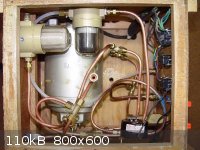
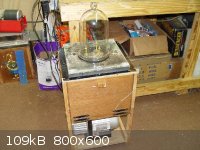
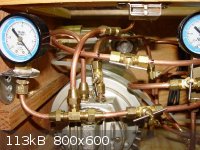
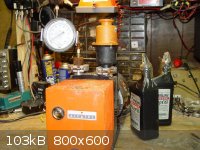
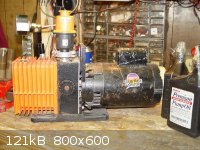
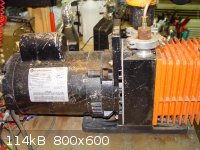
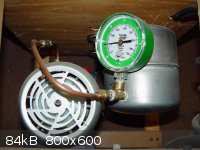
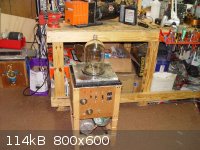
[Edited on 1-3-2011 by IrC]
"Science is the belief in the ignorance of the experts" Richard Feynman
|
|
|
vulture
Forum Gatekeeper
    
Posts: 3330
Registered: 25-5-2002
Location: France
Member Is Offline
Mood: No Mood
|
|
| Quote: |
One last thing. Does anyone know where to get user info for Alcatel? Damn hard to find, with the name connected to Lucent in a completely unrelated
technology. |
I feel your pain, I spent quite some time digging up a manual for our alcatel vacuum pump on the net. It's on another computer and I'll try to find
out where I got it tomorrow. Alcatels vacuum branch is now called adixen, but they don't seem to have manuals for older stuff on their website. They
might be of assistance if you contact them, however.
http://www.adixen.com/
One shouldn't accept or resort to the mutilation of science to appease the mentally impaired.
|
|
|
IrC
International Hazard
    
Posts: 2710
Registered: 7-3-2005
Location: Eureka
Member Is Offline
Mood: Discovering
|
|
Thanks Vulture. I searched that site a week ago but found nothing useful for the 2004A. In general all I found searching was rebuild kit parts lists
and one part location PDF but not a word otherwise. By this I mean some form of rebuild instructions which may have included oil level info, etc..
Emailed but heard nothing back. If you ever find your file I would be happy to see it posted here. Just a little maintenance information would be
helpful. Long ago I decided to not invest in anything the MFG makes hard to find info for but this Alcatel is so smooth and quiet (as well as very
high vacuum) an exception must be made.
"Science is the belief in the ignorance of the experts" Richard Feynman
|
|
|
vulture
Forum Gatekeeper
    
Posts: 3330
Registered: 25-5-2002
Location: France
Member Is Offline
Mood: No Mood
|
|
Attached you'll find a manual to the 2005 series of pumps, I don't know if it translates to your model. I got it from http://www.pascaltechnologies.com/ , maybe they want to help you out.
Attachment: alcatel 2005.pdf (988kB)
This file has been downloaded 694 times
[Edited on 5-1-2011 by vulture]
One shouldn't accept or resort to the mutilation of science to appease the mentally impaired.
|
|
|
IrC
International Hazard
    
Posts: 2710
Registered: 7-3-2005
Location: Eureka
Member Is Offline
Mood: Discovering
|
|
Thanks Vulture this PDF is perfect. Answered all of my questions. This plus the parts placement PDF for the 2004A give me all I need even if I never
do find the correct owners manual. I will keep searching for a service manual if it exists just in case I ever decide it needs a rebuilt. With a
flushing (wasting a QT of new high vac oil combined with refilling with a new QT (just under) it runs so perfectly I doubt I will ever need to rebuild
it. I am amazed at the quality of Alcatel pumps.
"Science is the belief in the ignorance of the experts" Richard Feynman
|
|
|
IrC
International Hazard
    
Posts: 2710
Registered: 7-3-2005
Location: Eureka
Member Is Offline
Mood: Discovering
|
|
Just an update and a question. I finally found my < 100 micron leak, it was the neoprene itself. 5/16" thick material and it is actually leaking
through the material. I made a new seal with a new piece - same problem. I need to find some of the 1/4" stuff identical to the old one used in the
big magazine lithography machines. No luck so far but I did learn it was a silicone type material which worked great under one micron.
Question: does anyone know of any sources for porosity information for various rubber-like materials? The neoprene I used was large 12"SQ sheets used
for making automotive gaskets. Nothing else locally around here and as stated in another post those fleabay sellers want insane prices for their
stuff.
For now I am working very hard to remove the old epoxy to reuse my original gasket. Not fun and I really want to make a brand new one if possible
within my budget.
"Science is the belief in the ignorance of the experts" Richard Feynman
|
|
|
vulture
Forum Gatekeeper
    
Posts: 3330
Registered: 25-5-2002
Location: France
Member Is Offline
Mood: No Mood
|
|
| Quote: |
No luck so far but I did learn it was a silicone type material which worked great under one micron. |
Be careful with which kind of silicone tubing you buy, IIRC some kinds of silicon polymers are actually O2 membranes.
http://www.arlon-std.com/Library/Guides/D116%20Haibing%20Zha...
One shouldn't accept or resort to the mutilation of science to appease the mentally impaired.
|
|
|
IrC
International Hazard
    
Posts: 2710
Registered: 7-3-2005
Location: Eureka
Member Is Offline
Mood: Discovering
|
|
Good to know if I ever decided to use flexible tubing. The material I was talking about is a big sheet to make the gasket for the base of the Bell
Jar. Long ago I started using only Cu tubing and flare fittings for all vacuum lines. Once in a while I make connections with air conditioning lines
(needle valves in ends) like are used on gauge sets. Not very often I prefer only copper but this can be hard depending upon what I am doing at the
time. The Alcatel sure liked the cleaning and oil change. Seems slightly quieter, and I think even better vacuum but still waiting to get gauges. I
also need to work on new plumbing say 2" diameter Cu to get better vacuum with the Alcatel. I have reached levels of evacuation I can no longer
measure accurately with the stuff I presently own. Still looking at various gauges, looking to build my own ion tube. Have quartz tubing up to 2"
diam. X 4' long but my oxy-acetylene outfit was stolen a few months ago and my budget has not allowed me to replace it yet. Was the only way I had to
work with the tubing outside of my diamond wheels I use to cut it. Need the hot flame to seal electrodes, using pure cobalt wire for that. Want to
build a plating setup to try plating Cu onto the wire where it goes through the glass or quartz depending upon what I am experimenting with. Probably
the most difficult thing to do in a home setup is coming up with leads with the same expansion as the glass or quartz. Not sure that applied to your
post, just thinking out loud.
"Science is the belief in the ignorance of the experts" Richard Feynman
|
|
|
peach
Bon Vivant
    
Posts: 1428
Registered: 14-11-2008
Member Is Offline
Mood: No Mood
|
|
{edit}I only saw your reply mid typing this, so I realise you've already got some of it covered and that the neoprene is for the chamber seal.
Neoprene is not a nice material at all. It's far too weak for hard chemical exposure, and it is porous yes. Whenever I think of it, I always get a
mental image of a wetsuit. What are you thinking of doing in the chamber? You could start with natural rubber, silicone or polysulphide sealants. I'm
not sure how they fair up in terms of numbers, but I suspect they'll all be better than neoprene. You could also try levelling the base of the bell
jar and using a high vacuum grease instead. Some searching around can net you a desiccator that has a ground flange for use with grease. If you find
the pressure isn't dropping how it should, my first port of call would be the copper fittings. If they're compressions, they are likely leaky and a
soldered option may be the way to go.{/edit}
This is an old, but very nice to read, manual on vacuum, showing how the guys began working on it back in the day - rated A* by John
Hi IRC,
I have taken one of those Alcatel's to bits, screw by tiny easy to loose part.
If the pump has been barely run, I doubt it will desperately need a rebuild and you'd be best off checking what pressure it's reaching first.
As I have mentioned before, physics is far more demanding on vacuums. A prime component of the vacuum it creates is the oil in there, as it can end
up full of solvent and water. Of coarse, if there is some 100C or below boiling thing in the oil, it will be trying to boil off and get out the
exhaust as you run the pump; so the pressure won't drop to it's full extent until all of that is gone (vacuum pump oils were developed to have very
low vapour pressures so they don't start off gassing under vacuum in the pump head). If you've just got the pump, and have a gauge handy, try
connecting the gauge to it and leaving it running overnight to see if the vacuum increases over 12h or so. It will drop a little normally anyway as
the pump head warms up, but if it keeps dropping all across the 12h period, there'll be something in the oil. It can take absolutely
to get moisture out, so the gauge may just sit there and not move. Even lighter oils will create a problem, especially as they will likely have a
higher specific heat capacity and so will take longer to boil off.
Mechanical dial gauges are okay for chemistry, but not much help for physics, because they can't pick up the changes very well as they approach the
maximum of a rotary - the typical dial gauges can't pick it up at all actually, as most have at best 1mBar divisions, and the rotary can theoretically
reach ^-3 mBar.
I was going to say, if it's been in the desert, that may be a good thing due to the heat and lack of humidity. But it depends where and how it was
stored and what it was used for I expect.
Looking at the pump, I see signs of rust on the external components. That suggests it's been somewhere fairly damp, as I've not seen the rust on mine
and 'grey drizzle' is the predominant weather system in the UK. 
If you look at the photo I've included at the end, you can see the insides of these pumps (Alcatels) look a lot like a sandwich, with blocks that
slide together. You can also see, they're CAKED in rust. This is quite normal in my experience, and is a sign that damp air has been running through
it - e.g. people have been leaving the pump running in a workshop as they get something ready, or they've been using it to boil off moisture.
Opening a pump and finding it looks like this is not a great experience, but it's also less of a problem than it looks. The actual chambers inside
are usually still shiny. The outside of the pump head rusts because the film of oil drips off it when not in use and the pump heads are often cast
iron.
When you say neoprene seal, do you mean the one around the oil box (the orange thing)? That shouldn't actually be exposed to the vacuum, it's more
like a collection pan that the oil sits in.
I would say you first goal should be a gauge so you can actually CHECK the pressure it's reaching, which is real important for physics work. If
you're predominantly interested in lower pressures, there are a number of HVAC gauges you can buy that use the convection / thermal conduction
properties of gas for measurement.
These are usually a lot cheaper than the pirani's in the link, but will read to 0.01mBar and can swap between units on the display. In my experience,
they start reading at about 25 - 50mBar. Being able to swap between units so easily is helpful when every person you speak to seems to have their own
preference for Pascals, PSI, microns, torr, mBar, ATM and so on.
If you search eBay for 'digital vacuum gauge', you'll see the HVAC ones come up at about $80 to $160.
You are right to save that pump for physics and use the diaphragms for chemistry. Provided they can get down to aspirator pressures, that's all
that's needed for distillation, filtration and so on, and they are far easier to make chemically inert.
I believe quite a lot of semiconductor labs are now ditching their rotaries for alternative rough pumps (oil free) so they don't have to think about
oil back streaming into the ultra high purity silicon as it's being processed - which is a problem for those guys as 5 minutes of reading about what
they get up to demonstrates.... they need it to be clean, super, duper clean to an atomic scale. They've been using turbo pumps for quite a while over
diffusions for the oil reason, but it's only been more recently that the vacuum companies have started coming up with suitable replacements for the
rotaries that usually back them.
I have a turbomolecular pump (as soon as the guy gets back about paying for it), but the leap in complexity of parts and costs is gigantic from
chemistry to that. For instance, normal seals aren't okay, and you have to start using bits of indium wire, copper gaskets, massive ISO flanges to
avoid choking, the gas behaves in a none fluid manner, bake out ovens, metal hoses, at least two different (expensive) gauges. It's normal for an
ultra high vacuum system to take a week or two of constant baking and pumping before it actually reaches the full vacuum; due to boil off inside the
system and the time it takes for the remaining molecules to randomly bounce into the diffusion or turbo pump's intake.
Random is the word here, as they no longer behave like the gases we can suck out of a straw or with a rotary. Part of the reason for the bake out is
to encourage things to boil off but also to increase the velocity of the molecules left in the chamber, so they are more likely to make a collision
with the walls that will bounce them at an angle towards the high vacuum intake (because are making more collisions per unit time than they were at a
lower temperature).
Due to the way the motion of the gas changes at this pressure, these pumps can't really be connected to the system by hoses, as it's effectively like
trying to hit ping pong balls through a window tens of meters away - almost all of them will miss and bounce back. This is why diffusion and turbo
pumps have such wide openings on the top and go on the bottom of the chamber. The length of the connection between the pump and the chamber is also
important - it usually shouldn't be more than the flange is wide.
Being able to establish an ultra high vacuum has been one of the drawbacks of the new silicon technologies, like quantum structures. The huge amount
of time involved in pumping the chamber down makes it slow and costly, and risks a lot if something goes wrong with a wafer in there.
Making your own ion gauge was something I was thinking about as well, but didn't put too much thought into it as I still have lots and lots of other
bits that need collecting before it's going to reach ion gauge pressures. You can't switch on ion gauges and such until the pressure is right down. I
think they tend to use iridium wire (a platinum, but with more mechanical strength to avoid warping of the electrodes / distortion / noise).
I would suggest you also ignore the ion gauge stuff until you have a system approaching a level that will need one - which means a diffusion or turbo
pump and all the related components / seals. You need to be using metal components for that, plastics and rubbers off gas too much as you enter that
region of pressure.
Calibrating a DIY ion gauge will also be an interesting challenge, as what do you have to calibrate it against? 
I was thinking my first bit of high vacuum physics would likely be PVD, and sputtering some mirrors - for a laser / telescope.
If the pump has been used to move cylinder gas, it's could just be rusty on the outside. Even if there is rust on the pump head, provided the actual
chambers are clean and free of sand, it'll still be okay.
Any thoughts, I'd be interested to chat,
John
When moisture strikes.

[Edited on 20-1-2011 by peach]
|
|
|
IrC
International Hazard
    
Posts: 2710
Registered: 7-3-2005
Location: Eureka
Member Is Offline
Mood: Discovering
|
|
If you look at the pics above you will see the Bell Jar sits on a flat Plexiglas surface. The gasket in question is just a simple ring about 7"
diameter, 1" wide, epoxied to the surface. The Jar sits on that. Before I had to rebuild the top I had one I cut from a sheet that had near zero out
gassing, the neoprene nightmare blows. Or is it sucks? The pump has little use on it. But it was stupidly stored on the floor in a closet with jugs of
every acid and combination of the nastiest assortment of chemicals. Some of the metal cans were paper thin and rusted beyond belief. Some had bottoms
falling out. A real pain safely and properly cleaning up the closet and getting rid of the trash.
When I stored the pump in my desert location it thanked me for getting it out of hell. Inlet and outlet were well sealed all this time and the pump
internally is as spotless as can be. Only used for intermittent experimenting, all the old look you see on it was simply from fumes around it as it
sat in on the floor. The oil was clean and clear, I just changed it because I am picky and I did not like where my little brother had kept the pump.
Everyone keeps mentioning about what goes on when the pump is moving much gas or air but I can tell you it never saw this.
Myself, I never turn a good pump on until the vacuum is at least down to 200 microns quite simply because I spent too many years of life never owning
a really good one. My brother got married shortly after he bought this one, she was always on his ass about wires and chems and things so he rarely
ever did any neat experiments. Probably part of why he is on second wife now and she is cool, into science and things but too bad, so sad, the pump
has been mine for years and he can't have it back. Actually he has another new one now anyway.
At least I taught him about what to store around what, where, and why. I had stored it for several years fighting illness, never getting to do much of
madsci. Not out of it completely but better enough to go crazy with some things that look cool. Actually, I am playing with my vacuum setup now as i
want to play with putting layers on quartz to make optical filters. Mostly because I want to build a UV camera and for the money everyone wants for
bandpass filters to hell with that I am going to build mine if at all possible.
When I am doing something with vacuum I have more than 10 different pumps and always use the crappy ones to move a large volume of anything. Only when
there is little air or other gasses left to move do I run my two good ones. By the way thanks for that great link I am reading it now. Good stuff.
[Edited on 1-20-2011 by IrC]
"Science is the belief in the ignorance of the experts" Richard Feynman
|
|
|
Tiberius_C
Harmless

Posts: 9
Registered: 3-11-2010
Member Is Offline
Mood: No Mood
|
|
Just a short note -- if anyone is still looking for cast vs extruded acrylic, McMaster-Carr carries it. Their website is
http://www.mcmaster.com
Prices aren't the cheapest overall, but I can vouch for their excellent customer service & prompt delivery.
|
|
|
IrC
International Hazard
    
Posts: 2710
Registered: 7-3-2005
Location: Eureka
Member Is Offline
Mood: Discovering
|
|
http://www.rhunt.f9.co.uk/Glass_Blowing/Glass_Blowing_Menu.h...
This person is really good at working with glass for vacuum applications. I thought some of you might find his information useful.
"Science is the belief in the ignorance of the experts" Richard Feynman
|
|
|
Regolith
Hazard to Self
 
Posts: 73
Registered: 4-2-2011
Location: Mining the moon.
Member Is Offline
Mood: Glacial
|
|
IrC Thats outstanding. I spidered his whole site and added it to my glassblowing archives.
That's pretty much an excellent starting point for both making vacuum devices like triodes etc and glassblowing in general. He uses basic torches and
things average people have just laying around. Although I have issue with some of his technique, breaking glass towards him, anyone who can make there
own filament light bulb gets a pass for the minor things. The zombies show up and your even making your own light bulbs... your set.
|
|
|
peach
Bon Vivant
    
Posts: 1428
Registered: 14-11-2008
Member Is Offline
Mood: No Mood
|
|
'Filament' is a dirty word! And soon the police will be raiding houses to find guys naked and surrounded by 100W filaments and wads of cash at 3am. As
they have now been taken out of production, yet are so good for using on dimmers.
Prepare to jizz in your pants gentlemen. Get a cup of coffee first and then enjoy;
<iframe sandbox title="YouTube video player" width="480" height="390" src="http://www.youtube.com/embed/gl-QMuUQhVM" frameborder="0"
allowfullscreen></iframe>
<iframe sandbox title="YouTube video player" width="480" height="390" src="http://www.youtube.com/embed/9S5OwqOXen8" frameborder="0"
allowfullscreen></iframe>
I would like to visit this man's house. And then never leave.
|
|
|
Magpie
lab constructor
    
Posts: 5939
Registered: 1-11-2003
Location: USA
Member Is Offline
Mood: Chemistry: the subtle science.
|
|
It is indeed a pleasure to watch a skilled craftsman make an intricate and antiquarian device using specialized equipment. I wonder if he makes a
profit making those tubes. Maybe he doesn't care.
The single most important condition for a successful synthesis is good mixing - Nicodem
|
|
|
peach
Bon Vivant
    
Posts: 1428
Registered: 14-11-2008
Member Is Offline
Mood: No Mood
|
|
I'm not sure, but I know tube fanatics will pay serious money for some of that stuff.
A top end hi-fi from these guys is going to set you back a good chunk of a million quids, or more. A lot of it is full of silver, since it's ever so
slightly better at conducting*** or uses cobalt / mumetal for the magnetics
Prices? If you have to ask, you're too poor. Get on with listening to your filthy 'dubstep' and 'rock and roll'.
I love the guy in the videos. It's what I'd like to be doing at his age. He's not just messing around painting kits, he's got all his stuff together
and is doing something really well. Something I haven't seen other people doing.
***During the development of the first nuclear weapons, the US government had everyone hand over their silverware to build the coils for the
separator. 
[Edited on 24-2-2011 by peach]
|
|
|
Regolith
Hazard to Self
 
Posts: 73
Registered: 4-2-2011
Location: Mining the moon.
Member Is Offline
Mood: Glacial
|
|
Yes that was amazing as hell... Also yes tubes these days are stupid expensive. Russia only recently started again making tubes. They had stopped
after the fall much to the dismay of audiophiles. People were recycling used tubes from old radar equipment for audio systems for a while.
Oh and rock and roll sounds amazing through tubes. So does dubstep I might add  .
Tubes generate harmonics not heard in transistors, or rather in a transistor it distorts with random interference. In a tube the distortion is
harmonic to the sounds going through it. .
Tubes generate harmonics not heard in transistors, or rather in a transistor it distorts with random interference. In a tube the distortion is
harmonic to the sounds going through it.
This seriously makes me want to make my own tubes as well. I buy them when I get a commission for a new amp. Peach is as usual correct. This slab of
black walnut and the tubes shown will be combined with transformers (pure silver wire wound toroids, that's getting to be the price of the tubes
themselves) to produce a tabletop tube amp. Price tag, over 1000 dollars for a simple design.
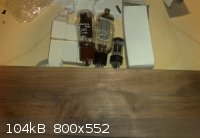
|
|
|
IrC
International Hazard
    
Posts: 2710
Registered: 7-3-2005
Location: Eureka
Member Is Offline
Mood: Discovering
|
|
I would not use beam pentodes for quality sound. Save the 811's for a freaky Tesla coil. Build your own sockets and use a pair of 813's. Besides in
the winter you could shut the heat off and bask in the warmth of monster glass jugs which are far more linear with greatly reduced odd harmonics.
Being rated to 20 MHZ or so you will have no problems mixing the ultrasonic products which add depth and presence in the audio range. I used two 813's
from an ion implanting machine from Microchip in Chandler to build the most powerful tube type Tesla coil I ever created. Last time I saw it was in
the instrument Lab of Arizona's power company Salt River Project. Never loan cool toys to friends I say. He likes it so much I cannot get it back.
Of course now you have ruined it, I should have been thinking stereo. If only I had known. The pain of it all. I am stuck listening to MP3's on this
computer.
Just realized I forgot to add:
When light bulbs are outlawed only outlaws will have light.
[Edited on 2-25-2011 by IrC]
"Science is the belief in the ignorance of the experts" Richard Feynman
|
|
|
| Pages:
1
2 |